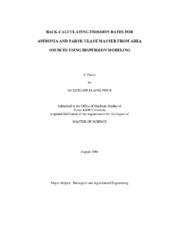| dc.description.abstract | Engineering directly impacts current and future regulatory policy decisions. The foundation of air pollution control and air pollution dispersion modeling lies in the math, chemistry, and physics of the environment. Therefore, regulatory decision making must rely upon sound science and engineering as the core of appropriate policy making (objective analysis in lieu of subjective opinion). This research evaluated particulate matter and ammonia concentration data as well as two modeling methods, a backward Lagrangian stochastic model and a Gaussian plume dispersion model. This analysis assessed the uncertainty surrounding each sampling procedure in order to gain a better understanding of the uncertainty in the final emission rate calculation (a basis for federal regulation), and it assessed the differences between emission rates generated using two different dispersion models. First, this research evaluated the uncertainty encompassing the gravimetric sampling of particulate matter and the passive ammonia sampling technique at an animal feeding operation. Future research will be to further determine the wind velocity profile as well as determining the vertical temperature gradient during the modeling time period. This information will help quantify the uncertainty of the meteorological model inputs into the dispersion model, which will aid in understanding the propagated uncertainty in the dispersion modeling outputs. Next, an evaluation of the emission rates generated by both the Industrial Source Complex (Gaussian) model and the WindTrax (backward-Lagrangian stochastic) model revealed that the calculated emission concentrations from each model using the average emission rate generated by the model are extremely close in value. However, the average emission rates calculated by the models vary by a factor of 10. This is extremely troubling. In conclusion, current and future sources are regulated based on emission rate data from previous time periods. Emission factors are published for regulation of various sources, and these emission factors are derived based upon back-calculated model emission rates and site management practices. Thus, this factor of 10 ratio in the emission rates could prove troubling in terms of regulation if the model that the emission rate is back-calculated from is not used as the model to predict a future downwind pollutant concentration. | en |


